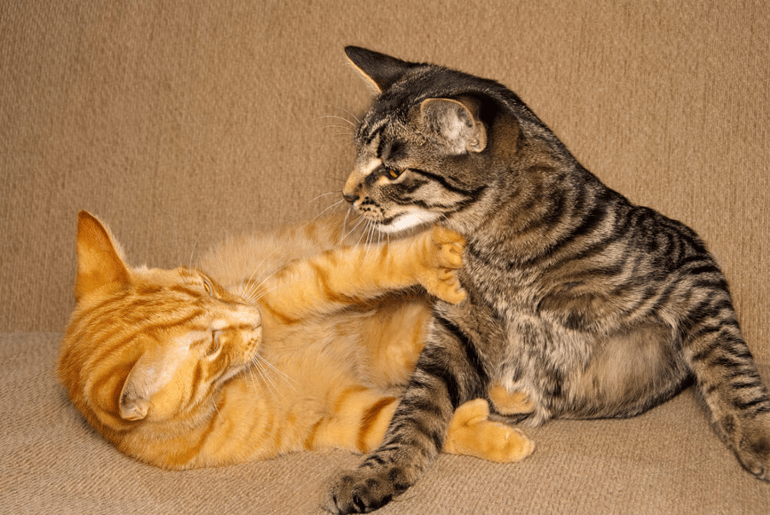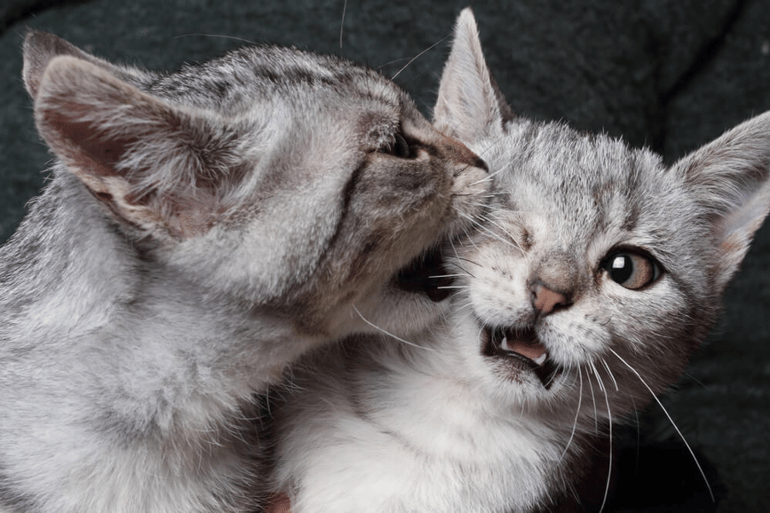How to Tell if Your Cats are Playing or Fighting
Sometimes it can be hard to tell if our purrfect pets are furry friends, or fierce foes!
From playful tumbles to play-fights, our cute kitties often pretend to be enemies and mock fight. This is completely normal cat behaviour and helps our pets to bond, set boundaries and get to know each other!
But, if your kitties seem a little too aggressive, it may be time to check if they’re playing or fighting. As cats with a real disagreement could cause one another harm or stress, it’s important to recognise the signs of a real cat-fight, and help them to get along!
Tips To Tell if Your Cats are Playing or Fighting
Watch their body language
While our kitties can’t directly tell us when they’re fighting, you can learn a lot from their body language!
The next time your pets are scrapping, watch them closely. Cats who are just playing and ‘mock’ fighting will often have their bodies positioned forward towards each other.
However, cats who are ready to fight may look defensive, will lean away from each other, and puff out their fur in order to look larger with their spine curved and legs raised to seem taller.

See if they’re taking turns
Playful kitties are happy to share and take turns! Chasing can be a common sign of both play and fighting, so if your pets seem to be running circles around you, watch to see if one cat in particular, is always ‘the chaser’ or is always more aggressive. This could be a sign of fighting rather than friendly play.
Look out for biting
Sometimes a small nibble can be a sign of playful over excitement! But if your kitties seem to bite a lot, are causing harm - or if one cat is always the one doing the biting, they are probably fighting. Biting should be minimal between playful cats, so watch out for any teeth!

Listen for loud kitties!
Are your cats very vocal? Are they hissing, growling, ‘screaming’ and shrieking at each other? While a small amount of noise is to be expected from playful pets, very loud interactions are an indicator of a fight. Intimidating noises are common between disagreeing kitties, so listen out for vocal pets - particularly if one cat yelps in pain.
Check for claws
While your pets may scratch and claw on their scratching post, happy cats shouldn’t claw at each other. Fighting cats will often have their claws out, ready to swipe or defend themselves - unlike playful kitties who more often have their claws retracted.
Look at ears and eyes
Ears and eyes are other key body language indicators that can tell you if your cats are happy or not!
Happy, playful cats will often have their ears forward, upright or slightly back. However, fighting kitties may have their ears turned back, often against their head. Aggressive kitties will often also stare at each other intensely, ready to jump into a scrap!
Check for injuries and stress
Playful, friendly cats shouldn’t cause any injuries to each other - and accidental injuries between furry friends are rare. So if your pets are causing harm to one another, or leaving each other shaken, nervous and tense after interacting, you likely have fighting kitties!
What to Do If Your Kitties Are Fighting
Having unhappy cats who don’t get along can be tough! If you notice that your pets are doing more than playing, it’s important to try to break up the scrap as soon as possible. Never physically intervene here, as you or your pets may be hurt. Instead, make a sudden loud noise such as a clap, or work to place a barrier between disagreeing pets.
If your cats seem to be fighting a lot, try to assess why this might be, and remove any causes of stress or conflict that could be impacting them. Using FELIWAY FRIENDS can also help to restore harmony, and reduce tension and fighting between cats. Plugged into the room where your cats spend the most time, you can create a calm, happy and peaceful kitty environment!
